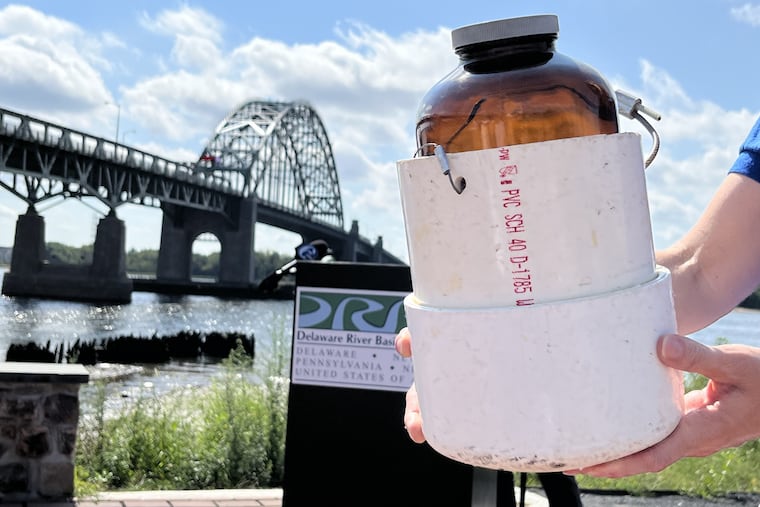Microplastics found throughout Delaware River and its tributaries
Microplastics continue to break down, getting into the food web where they can be ingested by fish, birds, and plankton.

Microplastics were found in all 15 locations in the Delaware River watershed that were tested the last several years in a study by the Delaware River Basin Commission (DRBC), meaning that tiny fibers of rayon, polyester, and other man-made fibers permeate the waterway.
“They were found in every sample and in every stream in every segment of the river,” said Jake Bransky, an aquatic biologist with the DRBC, a federal and interstate agency that manages the river. “So they are definitely pervasive.”
In addition, microplastics were found in all three types of collection methods used by the DRBC: a bottle, a net, and a more sophisticated device.
The river is a source of drinking water for 13 million people along its 330-mile course, including Philadelphia. Most microplastics, however, are removed from drinking water by filters. Microplastics have still been found in tap and bottled water, as well as seafood, but the impact on human health is not widely studied.
What is a microplastic?
Microplastics are particles smaller than 5 millimeters in diameter — about the size of a sesame seed. They come from many sources and include fibers, pellets, beads, foams, films, and fragments. They get in the water through litter, storm water, wastewater, the air, and from breakdown of buoys and boats.
Microplastics continue to break down eventually to a nano scale, getting into the food web, where they can be ingested by fish, birds, and zooplankton. The effects of that, however, are not well-studied. But it’s thought they can affect reproduction, cause biological stress, and even be toxic to livers and cells.
Fibers made up the biggest chunk of samples, Bransky said, suggesting man-made garments break down in washing machines and find their way into the river and its network. He said some washing machines are starting to come with filters that can remove smaller particles, but they are not yet mainstream.
Bransky also said plastic bag and plastic straw bans, such as those in effect in Philadelphia and New Jersey, help prevent more of the fossil-fuel-made products from littering banks and water before breaking down into smaller pieces that eventually become microplastics.
But he and other officials who announced the study’s results Tuesday at Lardner’s Point Park in Philadelphia, at the base of the Tacony-Palmyra Bridge, said larger plastics also plague the river.
John Moore, executive director of Palmyra Cove Nature Park, directly across the river in Burlington County, said up to 30 large contractor bags of trash were filled during one recent cleanup of the park — the debris having been washed in by tides. He noted that the river is much cleaner than decades ago and that peregrine falcons now call the bridge a home, bald eagles nest just downstream, and ospreys fish nearby.
That plastic threatens them as they eat aquatic life that might have ingested microplastics or if they become tangled in larger plastics.
The goal of the latest study was to understand how microplastics are distributed in the Delaware estuary, which is the tidal portion of the river running from Cape May to Trenton. It’s hoped that as the public becomes aware of the problem, efforts will be made to reduce the load.
What does the study show?
Microplastics have not been studied extensively along the Delaware River. Two previous studies focused on the nontidal portion of the river farther north and the Delaware Bay, farther south. This is the first to examine the issue in the heavily urbanized Philadelphia area.
The researchers collected samples at 15 sites in Pennsylvania, New Jersey, and Delaware, between Trenton and the Chesapeake & Delaware Canal. Temple University’s Water and Environmental Technology Center analyzed the data by counting each particle, its size, color, and composition. The data were also released through an online interactive map.
To conduct the sampling, Bransky and his team used three devices: a “grab sampler,” basically a 1-liter jar held in PVC pipe for protection and lowered off a bridge or pier; a Niskin sampler that can be lowered and activated by a trigger to collect from the bottom of a waterway; and a simple net with buoys. Each method has strengths and weaknesses, making it difficult to compare data from one site with another if the same method wasn’t used at each.
Microplastics were found in a variety of shapes, but fibers were the most abundant shape at all sites and levels. Polyester, rayon, and man‐made cellulosic fibers were the most common types.
The study received funding from the U.S. Fish and Wildlife Service through the National Fish and Wildlife Foundation’s Delaware Watershed Conservation Fund.